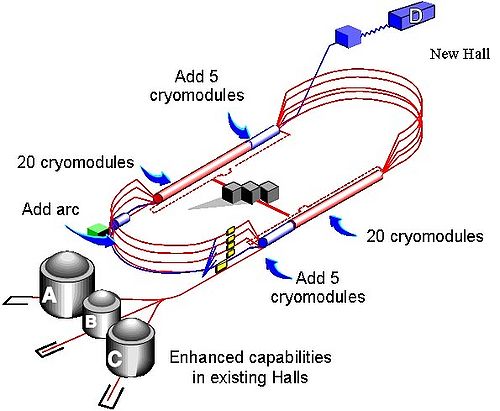Tamar Thesis CEBAF
The Continuous Electron Beam Accelerator Facility (CEBAF) at Thomas Jefferson National Accelerator Facility (JLab) contains two 0.5 GeV linacs connected by five sets of recirculated arcs and a 45 MeV polarized electron beam injector with a transverse emittence of less than mm-mrad and a longitudinal emittence of less than keV-degrees. In order to minimize the total accelerator circumference, the accelerator structure was arranged in two separate linac segments. Each linac segment contains 25 cryomodules that house 8 superconducting radio-frequency cavities. Each cryomodule is seperated by a vacuum port, beam diagnostics, and quadrupole and dipole magnets. Quadrupole and dipole magnets are used focus and steer the beam. Electrons are accelerated by electric fields within niobium cavities that have been cooled to 2 K using liquid helium. The field within the cavities is created by klystrons that propagated radio frequency waves through wave guides to the accelerating cavities.<ref name="Grunder1987"> Grunder, H.A., et al. (1987). The Continuous Electron Beam Accelerator Facility. CEBAF-PR-87-017.</ref>

|
|
Figure 1. CEBAF 12 GeV upgraded accelerator. |
A Klystron is a microwave amplifier used to generate electromagnetic waves that are transported by a waveguide from the Klyston to the niobium cavity. The electromotive force (EMF) induced in the RF cavity is roughly parallel to the beam axis and decaying to zero radially at the walls. The EMF induces charge on the interior surfaces of the cavities such that the electrons moving through the cavity see a positive charge in front of them and accelerate towards that charge. After the beam reaches the desired energy the three beams are separated at the switch yard and sent to the experimental halls labeled A, B and C using an RF kicker. As a result, the Klyston establishes an electromagnetic wave within the niobum cavity that collects electrons on the crest of the wave into bunches that are spaced by 2.04 ns.<ref name="Diamond1987"> Diamond, W. (1987). The Injector for the CEBAF cw Superconducting Linac. CEBAF-PR-87-011.</ref>
| Quantity | Value |
|---|---|
| Electron beam energy E (GeV) | |
| Max Electron beam current in one Hall() | 100 |
| Energy spread () | |
| Electron beam polarization | 40-80% |
| Simultaneous beams | 3 |
| Number of linac segments | 2 |
| Number of passes | 4 |
| Maximum energy gain per pass (GeV) | 1.5 |
| Table 1. The CEBAF accelerator parameters <ref name="Grunder1987"> Grunder, H.A., et al. (1987). The Continuous Electron Beam Accelerator Facility. CEBAF-PR-87-017.</ref> |
Polarized electron beams are created at JLab using a GaAs photocathode. The polarized electrons are produced by bandgap photoemission from a strained GaAs cathode using a tunable Ti-Saphire laser having wavelengths from 780 to 850 nm with at least 500mW of output power<ref name="HansknechtPoelker2006> Hansknecht*, J. and Poelker, M. (2006). Synchronous photoinjection using a frequency-doubled gain-switched fiber-coupled seed laser and ErYb-doped fiber amplifier. Phys. Rev. ST Accel. Beams 9, 063501.</ref>. When the cathode is exposed to circularly polarized laser light, polarized electrons move from the valence region to the conduction band. In order to free the electrons from the conduction band, the surface of the GaAs cathode is coated with a single layer of cesium and fluorine. As a result, electrons in the conduction band are bound to the surface of the material by only 4 eV. For the EG1b experiment, the direction of the electron polarization was flipped with a frequency of 1 Hz by reversing the laser polarization using a pockel cell. The electron beam polarization for each hall can be changed with a Wien Filter, it can rotate electron spin without changing its momentum. <ref name="Engwall1992"> Engwall, D.A., et al. (1992). A spin manipulator for electron accelerators. CEBAF-PR-92-019</ref>
The beam polarization is monitored using a 5 MeV Mott polarimeter and a Moller polarimeter in Hall B. The average electron beam polarization during the EG1b experiment was measured by the Hall B moller polarimeter to be ()%.
The integrated electron beam current is measured using a Farady cup. The Faraday cup is located downstream of the CLAS target and contains several layers of lead and scintillator in order to create a large amount of detected secondary particles from the primary electron beam. The position of the beam is monitored with a three beam position monitors. The profile of the beam is monitored with a harp scan, a device with thin iron and tungsten wires moved around the beam.
Notes
<references/>
http://www.jlab.org/div_dept/admin/publications/papers/92/PR92-019.pdf